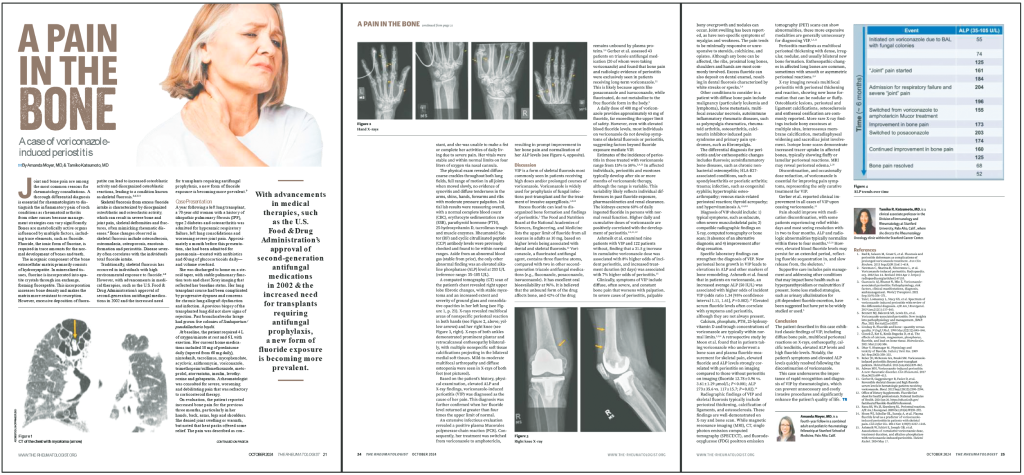 I often think about medical literature as a sprawling metropolis. There are towering skyscrapers of randomized controlled trials, lofty schools of systematic reviews and meta-analyses, and verdant parks of qualitative studies. Much less assuming are the case reports, which are sort of like homesteads for the majority of people who publish and contribute to the vitality of medical literature. They are often overlooked or dismissed as anecdotal, but the truth is that case reports remain a crucial part of how we learn, adapt and advance our field, especially in rheumatology.
I often think about medical literature as a sprawling metropolis. There are towering skyscrapers of randomized controlled trials, lofty schools of systematic reviews and meta-analyses, and verdant parks of qualitative studies. Much less assuming are the case reports, which are sort of like homesteads for the majority of people who publish and contribute to the vitality of medical literature. They are often overlooked or dismissed as anecdotal, but the truth is that case reports remain a crucial part of how we learn, adapt and advance our field, especially in rheumatology.
Although they lack the statistical power of large studies, case reports hold a different kind of, almost imaginative, power: They capture the nuances of disease, document the rare and unexpected, and remind us of the complexity of individual patient experiences. They are often the first whispers of new syndromes, unrecognized drug reactions or paradigm-shifting treatment responses. They also serve as an entry point into academic writing for trainees and early career physicians, offering a unique opportunity to sharpen clinical reasoning and storytelling skills.
So why do case reports matter, and how can aspiring authors craft a case report that is both meaningful and novel. Let’s rheuminate!
Why Case Reports Matter
At its heart, rheumatology remains a specialty that emphasizes pattern recognition. Clinicians must connect seemingly disparate symptoms, signs and results into a coherent diagnosis. Given the heterogeneity of the autoimmune and inflammatory diseases that we encounter, no two patients present exactly alike, and many diagnoses hinge on recognizing subtleties that deviate from textbook descriptions.
This is where case reports are so vital. They document clinical scenarios that expand our understanding of disease phenotypes, challenging us to refine our diagnostic frameworks. For example, case reports continue to expand our characterization of immune-related adverse events (IRAEs) associated with checkpoint inhibitors, which in turn leads us to have a deeper appreciation of T cell immunology.1 Similarly, Graham Hughes and colleagues’ case reports in the 1980s of young patients experiencing recurrent thrombosis, pregnancy losses and neurological symptoms later led to the recognition of antiphospholipid antibody syndrome.2 Of course, these reports do not offer definitive conclusions, but they do provide the first signals that drive deeper investigation.
Beyond novelty, case reports also serve as practical teaching tools. Many of us learned rheumatology through the study of individual cases, whether presented in morning report, shared during grand rounds or immortalized in journal articles. A well-written case report doesn’t just say, “Look at how cool this rare disease is,” it invites readers into the clinical, decision-making process, illuminating key diagnostic dilemmas and therapeutic considerations.
Finally, case reports preserve the human element of medicine. In a world increasingly dominated by large datasets and predictive algorithms, they remind us that medicine is still, at its core, about individual patients with unique stories. A case report, when written well, is not just a clinical observation, but rather a narrative that conveys curiosity, humility and the never-ending process of learning. The most memorable case reports are those that bridge the worlds of narrative medicine with that of evidence-based practice. They reconcile the perspectives of the clinician and the patient with the diagnostic reasoning process through compelling and accessible writing.
The Art of Writing a Case Report
Despite their clear and self-evident value, not all case reports are created equal. Many end up as forgettable footnotes, lost in the archives of specialty journals, while others stand the test of time and become classics in their own right. What separates a good case report from one that simply adds to the noise?
First, start with the right case. Not every unusual case deserves a case report. The best case reports balance novelty with clear learning points. A report of an ultra-rare disease that follows a textbook course may be interesting, but if it does not challenge existing knowledge or offer new insights for readers, it risks being redundant.
Instead, I would recommend potential writers to look for cases that fill a niche. Three prototypical niches include: 1) expanding our understanding of a known disease, such as an atypical and consequential presentation of lupus or vasculitis, 2) highlighting a novel treatment response, such as unexpected efficacy or an adverse reaction, or 3) raising awareness of a diagnostic pitfall (e.g., mimickers of rheumatic disease that could lead to misdiagnosis).
When in doubt, ask yourself: What does this case teach that could change the way that my colleagues approach similar patients in the future? If the answer is “not much,” there may be other opportunities heading your way.
Tell a Story, Not Just a Sequence of Events
A compelling case report is more than just a timeline of symptoms, labs and treatments. It is, at its heart, a narrative—one with a beginning, a middle and an end. The best case reports engage the reader with a clinical mystery, guiding them through the reasoning process that led to the diagnosis and treatment decisions.
Consider structuring your case in a way that mirrors real-world clinical reasoning.
- Before anything, set the scene: Start with a concise, but vivid, description of the patient’s presenting symptoms and why they matter to the patient.
- Then, build suspense by adding to the evidence. You should be judicious in providing just enough information for readers to be engaged, but not so much that they lose the plot.
- Only then, once you have your reader hooked, should you reveal your differential diagnosis, thoughtfully, integrating pathophysiology and clinical presentation as much as possible.
- Finally, reflect on the ultimate outcome and how that reasoning process brought you to that outcome.
Combined with eye-catching figures, illustrations and tables, this narrative approach can make your case report engaging and allow the reader to learn actively rather than passively.
Support Your Observations with Literature
Going back to the metaphor of the metropolis of medical literature, it’s important to remember that case reports cannot stand alone. They exist within neighborhoods of other case reports and are dependent on other types of literature. Therefore, it shouldn’t be surprising that the best case reports contextualize novel findings within existing knowledge.
Toward that end, if you are writing a case report, make sure to conduct a very thorough literature search. Any editor worth their salt will be looking for the following within the discussion section: gaps in knowledge that the case addresses, distinctions between this case and prior reports, and limitations that prevent over-generalization. By grounding your report in evidence, you strengthen its impact and credibility.
Keep It Concise & Clear
The overriding challenge of writing a case report is that case reports are fairly short. Most journals have strict word limits (typically 1,000–1,500 words), so every sentence must serve a purpose. Use clear, direct language, avoid unnecessary jargon, and focus on the key takeaways. The CARE Guidelines and Checklist may provide authors some assistance in structuring their case reports.3
From a more literary standpoint, I would advocate that writers use the narrative principle of Chekhov’s gun. Named after the famed 19th century Russian playwright, the principle highlights the economization of details. According to Chekhov, “If in the first act you have hung a pistol on the wall, then in the following one it should be fired. Otherwise don’t put it there.” Within the context of case reports, keep the past medical history, medication lists and review of systems pertinent.
In addition to the words within the narrative, tables and figures can be powerful tools to convey information efficiently. If you have a histopathology slide or relevant radiograph, include it. Tables of differential diagnoses with rationales are often helpful to guide readers through walls of text. And some of the most readable case reports are those that use timelines and graphs to show connections between the various findings and the final diagnosis.
Balancing Novelty & Learning
One of the most common pitfalls in case reporting is the overemphasis on novelty at the expense of clinical relevance. Although an exceedingly rare syndrome may be intriguing, its value is limited if it lacks generalizability. Indeed, the “first of its kind” boast is of little importance if readers can’t directly benefit from it in their practice. Although not easy to do, the best case reports strike a balance: They highlight something unusual, but connect it to broader themes in clinical practice.
A case of dermatomyositis flaring following influenza infection, for example, is intriguing. But what makes it valuable is the discussion about immune dysregulation, preventive health and vaccinations, and how to recognize patients who may be at risk for similar presentations.
Conversely, a report of rheumatoid arthritis masquerading as polymyalgia rheumatica is not exactly rare but can be compelling if it helps clinicians recognize the red flags that prevent misdiagnosis.
When in doubt, I would recommend going back to the reason why you wanted to write this case to begin with and consider how to convey your enthusiasm to readers.
Choose the Right Journal
Identifying the right journal to submit your case report is arguably the most crucial step in the publication process. It’s deeply unfortunate that many journals no longer accept case reports. I understand the argument that case reports don’t belong in high-impact medical journals. Still, I can’t help but believe it is fundamentally their loss.
Within the field of rheumatology, there are many places where you can submit your case reports. The Rheumatologist is certainly one of them, and we welcome compelling, novel and consequential reports. Additionally, ACR Open Rheumatology has opened its pages to case reports, and Arthritis Care & Research has its Clinicopathological Conferences, a modified version of the case report. Instructions for submission can be found on their websites.
My final tip for any case report writers is to not be discouraged by rejection. Take it from me: Editors are not eager to reject your hard work. Rather, we want to see a balance of content within and throughout issues. If you dedicate yourself to honing a high-quality case report, chances are that you can get it published somewhere.
The Future of Case Reports in Rheumatology
The rise of big data and artificial intelligence has, in some ways, threatened to overshadow the value of single cases. With machine learning algorithms capable of analyzing thousands of patient records, why should we still focus on individual stories?
The answer is simple: Data can show us trends, but case reports show us nuance. They provide the granularity that large datasets often miss—the specific features of a disease that don’t fit neatly into a category, the unexpected patient response that defies statistical probabilities. They also allow for rapid dissemination of clinical insights that might take years to be confirmed in larger studies.
Moreover, case reports serve an important role in medical education. They train us to think critically, to approach each patient as a unique individual rather than a data point. They remind us that in medicine, the rare and the common coexist, and that a single observation—if thoughtfully documented—can influence practice in ways we might not anticipate.
Conclusion: Every Case Tells a Story
Harkening back to that ever-expanding city of medical literature, I hope I’ve convinced you to not just gaze at the beauty of skyscrapers and monuments built by well-known rheumatologists but to notice the humble homes made by teams of private practice rheumatologists, residents, fellows, medical students, interprofessional team members and more. These unassuming case reports are truly at the center of academic rheumatology, not because they offer definitive answers, but they invite us to ask provocative questions. They keep us engaged with the clinical puzzles that make our field so intellectually rewarding. They allow us to contribute to the collective knowledge of our specialty, even if we’re not running clinical trials or publishing large cohort studies.
So the next time you encounter a patient whose case challenges your assumptions or expands your understanding, consider writing it up, not because it’s rare or novel, but because it has a meaningful place in the shining city of medical literature.
 Bharat Kumar, MD, MME, FACP, FAAAAI, RhMSUS, is the director of the rheumatology fellowship training program at the University of Iowa, Iowa City, and the physician editor of The Rheumatologist. Follow him on X (formerly Twitter) @BharatKumarMD.
Bharat Kumar, MD, MME, FACP, FAAAAI, RhMSUS, is the director of the rheumatology fellowship training program at the University of Iowa, Iowa City, and the physician editor of The Rheumatologist. Follow him on X (formerly Twitter) @BharatKumarMD.
References
- Spiers L, Coupe N, Payne M. Toxicities associated with checkpoint inhibitors—an overview. Rheumatology. 2019 Dec;58(Suppl 7):vii7–vii16.
- Hughes GR. Thrombosis, abortion, cerebral disease, and the lupus anticoagulant. Br Med J (Clin Res Ed). 1983 Oct 15;287(6399):1088–1089.
- Gagnier JJ, Kienle G, Altman DG, et al. The CARE guidelines: Consensus-based clinical case reporting guideline development. BMJ Case Rep. 2013 Oct 23;2013:bcr2013201554. doi: 10.1136/bcr-2013-201554. PMID: 24155002; PMCID: PMC3822203.

